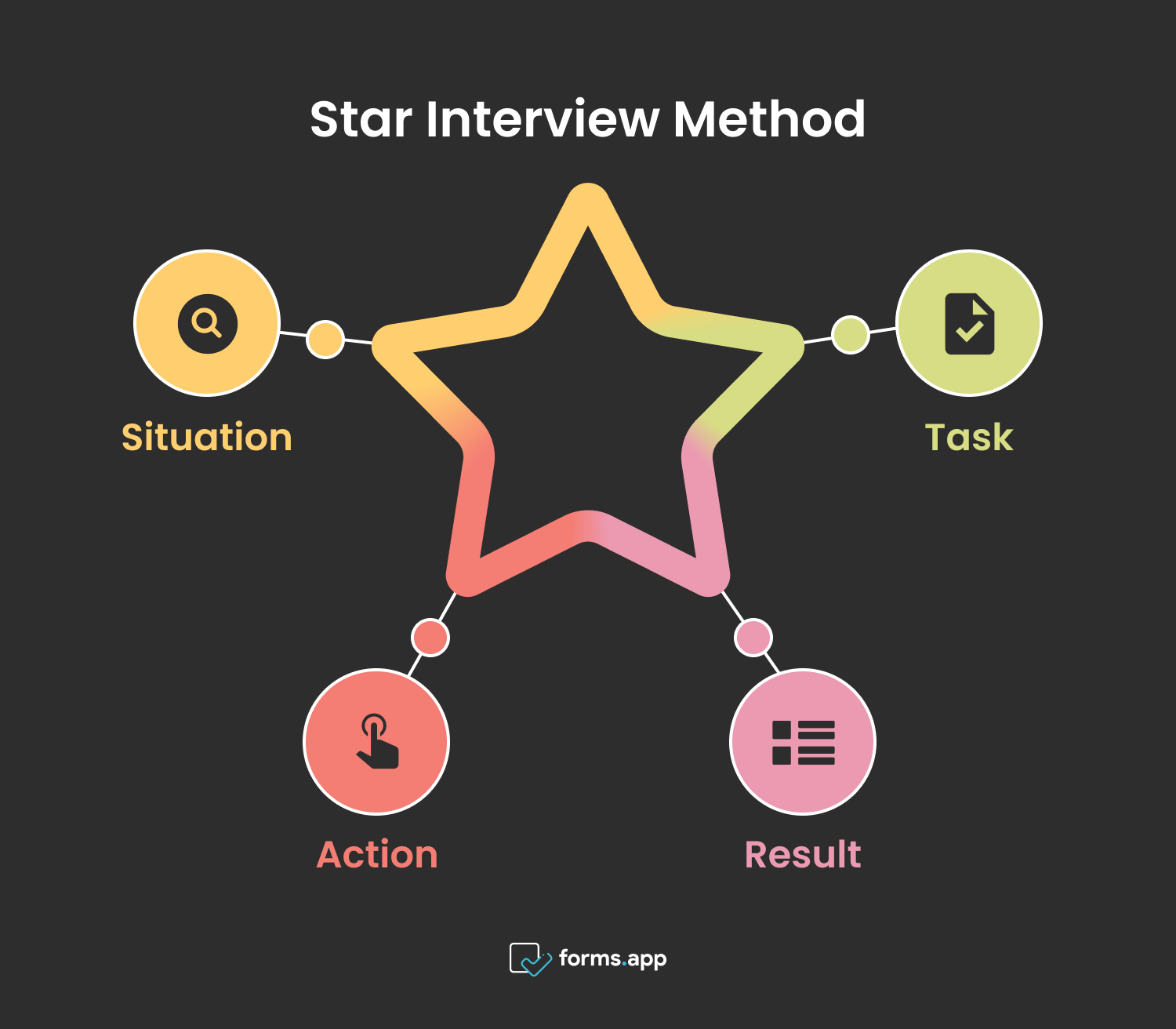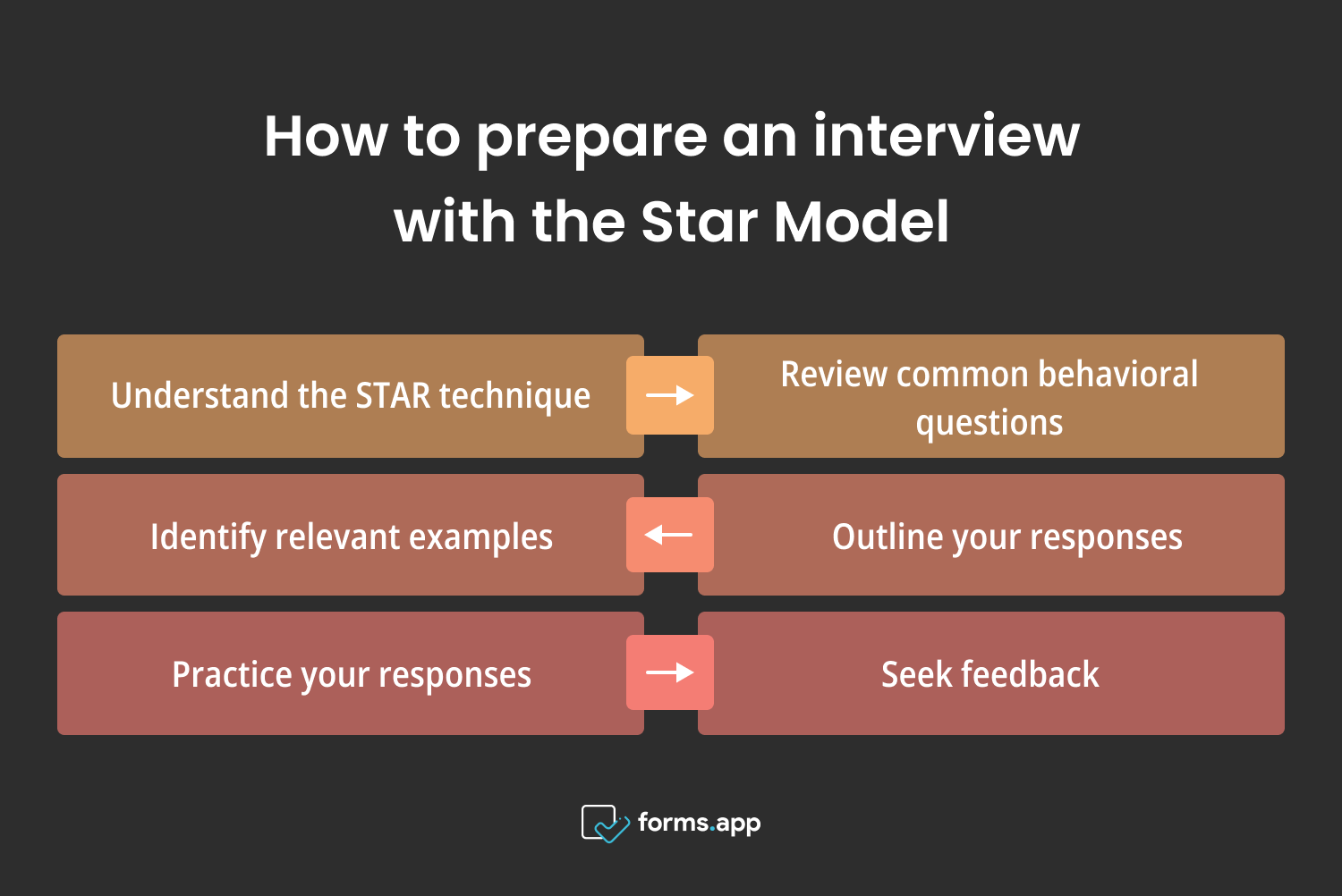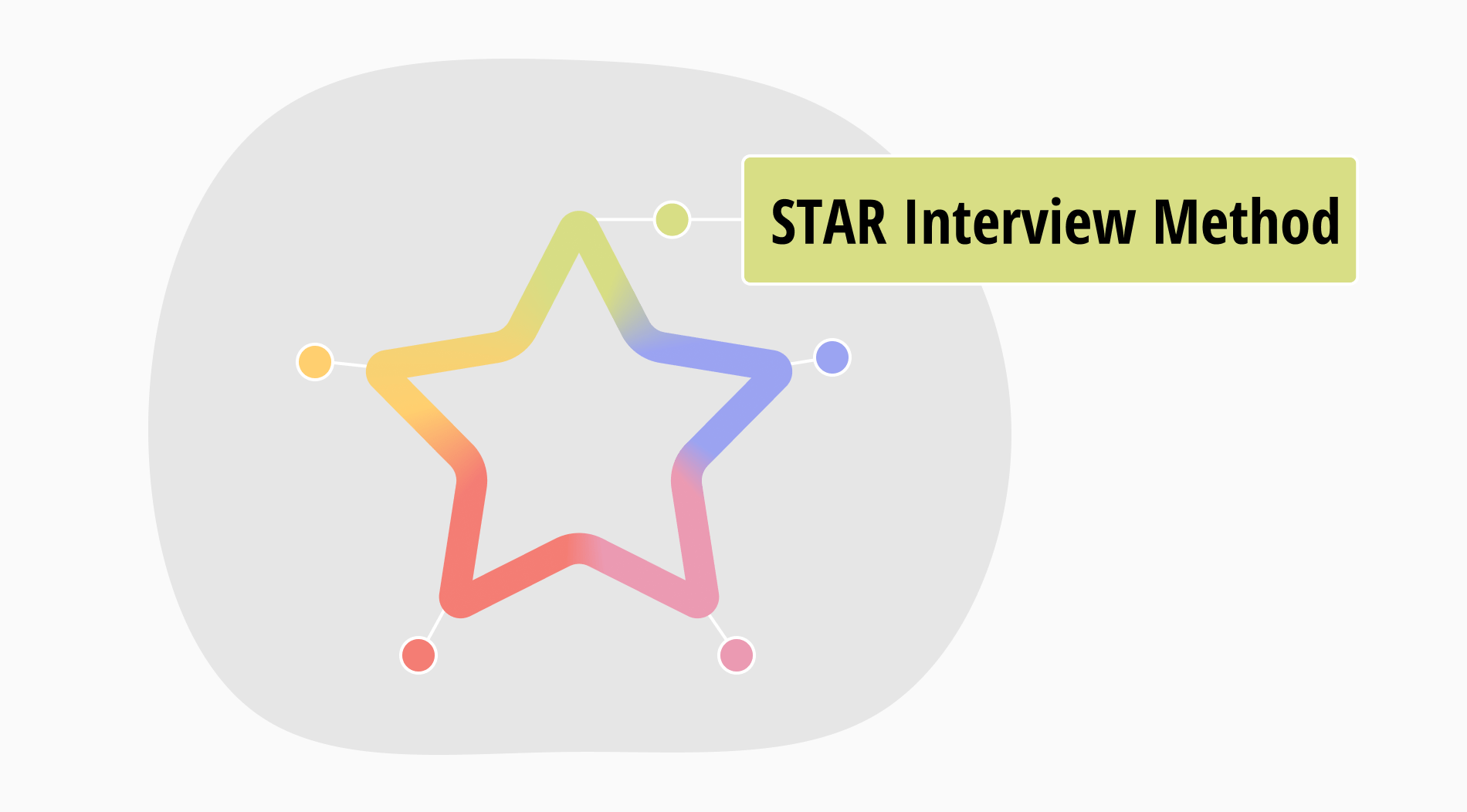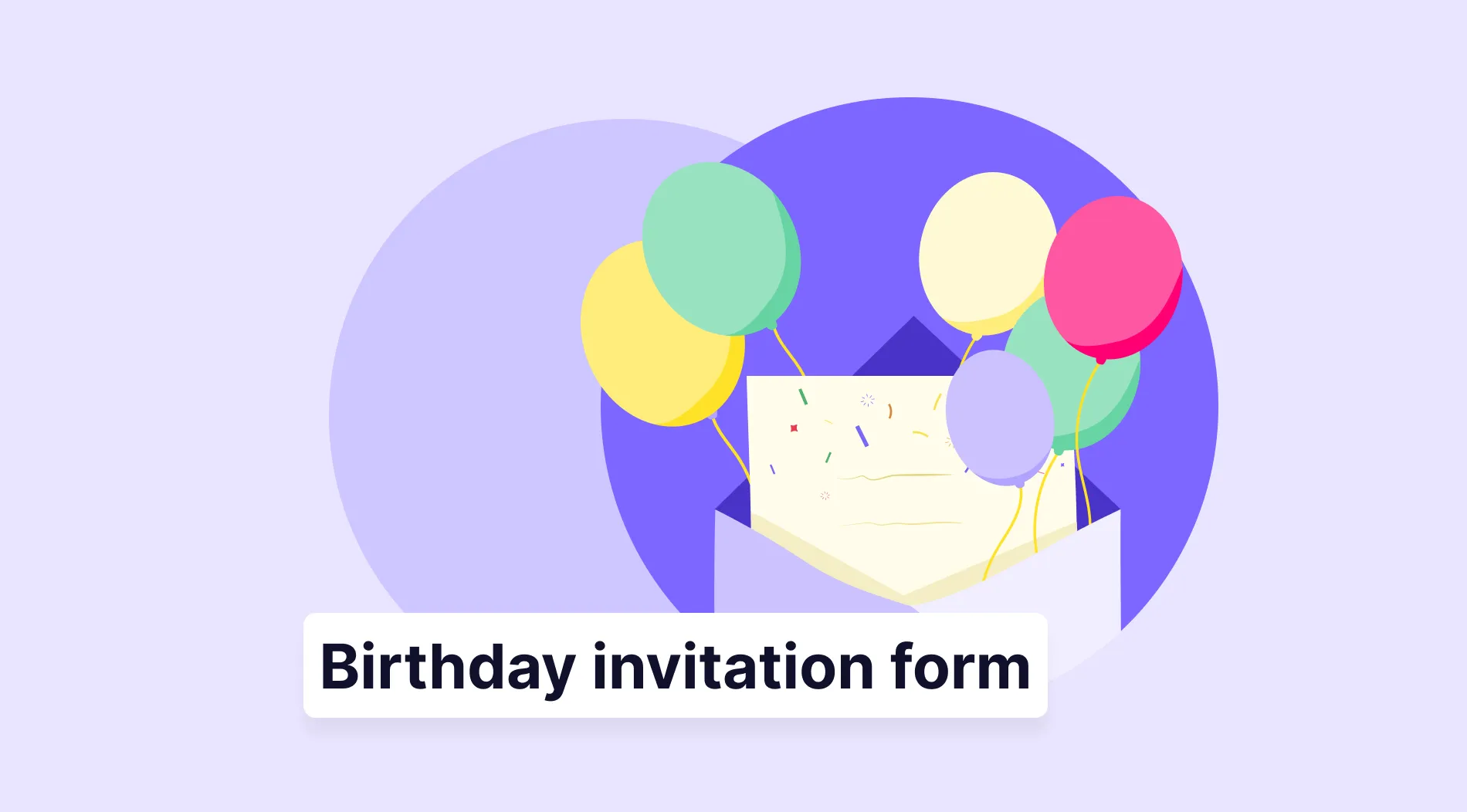In today’s competitive job market, interview methods have become essential tools for employers seeking top talent. These methods enable employers to assess candidates’ ability to handle real-world situations, problem-solve, and demonstrate key competencies. As businesses strive for efficiency and effectiveness, mastering interview techniques is crucial for making informed hiring decisions.
This article will cover one of the behavioral interview methods, the STAR Interview model. We will discuss how a candidate can prepare for it and how an employer can conduct it. You will see some example questions and proper answers to them. We will also answer some of the frequently asked questions about the STAR Interview method.
What is the STAR interview method?
The STAR interview method is a structured approach used by job seekers to answer behavioral interview questions. Employers can also use this behavioral model to prepare their interviews for the employment process. The acronym STAR stands for Situation, Task, Action and Result.
The STAR Interview model provides a systematic framework for effectively communication your experiences and competencies in response to behavioral interview questions. By following this approach, you can provide clear, concise, and compelling examples that demonstrate your qualifications and suitability for the position. Now, let’s delve into the acronym:

Star interview method
1- Situation
The Situation component sets the stage by providing context for the interviewer. This is where you describe the background or circumstances surrounding a specific challenge, project, or task you encountered in your previous experience. It’s important to give enough detail to help the interviewer understand the context of the situation, including the setting, the people involved, and any relevant background information.
By painting a clear picture of the situation, you lay the foundation for the interviewer to understand the challenge you faced and the actions you took to address it. This helps you set the stage for a subsequent discussion of good quality.
2- Task
In the Task segment, you articulate the specific objective or goal you were tasked with achieving within the given situation. This entails explaining the purpose of your actions and the expectations set for you. By clearly defining the task at hand, you enable the interviewer to comprehend the significance of the objectives you were working towards and the parameters in which you operated.
This segment serves as a crucial foundation for understanding the reasons behind your subsequent actions and decisions. It is also essential for providing insight into any constraints, deadlines, or challenges associated with the assignment. This contextual information helps the interviewer grasp the complexity of the task and the considerations you had to navigate while working towards the completion.
3- Action
In the Action component, you look into the specific steps taken to address the situation and accomplish the assigned task. This involves detailing the actions you implemented, the strategies you employed, and the decisions you made to navigate the challenge effectively. In other words, it provides a comprehensive overview of the actions.
You also showcase your problem-solving skills, initiative, and ability to take decisive action in challenging circumstances. It is crucial to highlight not only what you did but also why you chose those particular actions and how they contributed to achieving the desired outcome. This demonstrates your ability to analyze situations critically and adapt your approach as needed.
4- Result
In the Result component, you discuss the outcomes or consequences of your actions. This entails outlining the impact of your efforts and highlighting the results achieved as a result of your actions. By quantifying the outcomes and emphasizing the positive results, you demonstrate the effectiveness of your approach and the value you contributed to the situation.
It is essential to provide concrete examples, such as metrics or tangible achievements, to support your claims and show the tangible benefits of your actions. Additionally, reflecting on any lessons learned or areas for improvement further enriches your response and demonstrates your ability to evaluate and adapt based on outcomes.
How to prepare for an interview with the STAR method
Preparing for an interview with the STAR behavioral interview method involves structured planning to effectively communicate past experiences. There are several steps to ensure that you are ready to exhibit your skills and abilities during the interview in a confident manner. You can create a star interview method template for yourself. Follow these steps to give good answers:

Steps to prepare an interview by using the Star Model
- Understand the STAR technique: Familiarize yourself with the Situation, Task, Action, and Result framework. This involves grasping the significance of each component and how they contribute to structuring your response during the interview.
- Review common behavioral questions: Research typical interview questions to anticipate what may be asked. Look for questions that prompt you to discuss past experiences, challenges overcome, and achievements attained.
- Identify relevant examples: Reflect on your experiences to find suitable examples that demonstrate your skills. Consider various aspects of your professional, academic, and personal life where you showed leadership, problem-solving, and teamwork skills.
- Outline your responses: Structure your answers using the STAR method to ensure clarity and conciseness. Create a framework for each example that outlines the situation, task, actions taken, and results achieved.
- Practice your responses: Rehearse delivering your answers to improve confidence and fluency. Practice speaking naturally while maintaining focus on the key components of the STAR method.
- Seek feedback: Get input from friends or mentors to refine your responses and enhance your interview performance. Ask for constructive criticism on your examples, clarity of communication, and overall presentation style.
How to conduct your interview using the STAR method
Employers or human resources personnel can also conduct job interviews using the STAR interview method to effectively assess candidates’ past experiences and behavioral competencies. You can simply follow the steps below to ensure a structured and insightful interview process with the candidate:

How to use the Star Method in an interview
➡️ Understand the STAR method: As a person who will conduct the interview, you also need to get basic knowledge about the Situation, Task, Action, and Result framework. This provides a consistent structure for evaluating candidates’ responses and comparing their experiences.
➡️ Develop interview questions: Craft behavioral job interview questions that align with the job requirements and competencies sought. These questions should prompt candidates to provide specific examples of their past behavior in relevant situations.
➡️ Probe for details: During the interview, delve deeper into candidates’ responses by asking follow-up questions. Probe for specific details about their actions, decision-making process, and the outcomes of their actions.
➡️ Evaluate responses consistently: Evaluate candidates’ responses based on the criteria outlined in the job description. Use the STAR framework to assess the relevance, depth, and effectiveness of their examples.
➡️ Provide feedback (optional): Offer constructive feedback to candidates at the end of the interview. Highlight areas where their responses demonstrated strong competencies and areas for improvement.
STAR interview question examples
There are a lot of STAR Interview question examples, and they can all look into various areas, skills, and experience. These questions delve into candidates’ past experiences to assess their abilities, behaviors, and problem-solving approaches. From teamwork and leadership to adaptability and conflict resolution, STAR questions offer insight into candidates’ different capabilities.
Let’s look at some common behavioral interview questions:
Communication skills
- Can you provide an example of a time when you had to effectively communicate complex information to a diverse audience? How did you ensure clarity and understanding?
- Describe a situation where you encountered miscommunication in a team project. How did you address it and ensure effective communication forward?
- Share an experience where you had to deliver difficult feedback to a colleague or team member. How did you approach the conversation, and what was the outcome?
Interpersonal skills
- Describe a situation where you had to resolve a conflict between team members. How did you approach the situation, and what steps did you take to achieve a resolution?
- Share an example of a time when you had to collaborate with someone difficult to work with. How did you maintain a productive working relationship?
- Can you remember a situation where you had to persuade a colleague or team to adopt your idea or approach?
Decision-making skills
- Can you provide an example of a difficult decision you had to make under pressure? How did you weigh the options and conclude?
- Describe a situation where you had to decide with limited information or resources. How did you gather data and assess risks before making your choice?
- Share an experience where you had to make a decision that was not popular with your team or stakeholders. How did you handle resistance and maintain confidence in your choice?
Leading skills
- Describe a project or initiative you led from conception to completion. How did you inspire and motivate your team to achieve their goals?
- Share an example of a time when you had to take charge in a crisis or emergency. How did you provide direction and support to ensure a positive outcome?
- Can you recall a situation where you had to delegate tasks effectively to achieve a common objective? How did you distribute responsibilities and ensure accountability?
Technical skills
- Can you provide an example of a complex technical problem you solved in a previous role? How did you analyze the issue and develop a solution?
- Describe a time when you had to learn a new technology or tool to complete a project. How did you approach the learning process and apply your new skills?
- Share an experience where you had to troubleshoot a technical issue under tight deadlines. How did you diagnose the problem and implement a fix?
Stress management
- Describe a time when you had to handle multiple competing priorities or tight deadlines. How did you prioritize tasks and manage your time effectively?
- Share an example of a high-pressure situation you encountered at work. How did you remain calm and focused under stress?
- Can you recall a time when you had to deal with a difficult or demanding client or stakeholder? How did you manage their expectations and maintain professionalism?
Problem-solving
- Can you provide an example of a complex problem you encountered in a previous role? How did you analyze the situation and develop a solution?
- Describe a time when you had to think creatively to solve a challenging problem. What innovative approaches did you consider, and what was the outcome?
- Share an experience where you had to troubleshoot an issue with a product or process. How did you identify the root cause and implement a fix?
Strategic thinking
- Describe a project where you had to develop a long-term strategy to achieve a specific goal. How did you assess market trends and competitor activities to inform your strategy?
- Share an example of a time when you had to make strategic decisions to adapt to changes in the business environment. How did you anticipate future challenges and opportunities?
- Can you recall a situation where you had to identify and capitalize on emerging trends or opportunities in your industry? How did you develop and execute a strategic plan?
How to answer questions using the STAR method
Answering questions using the STAR method involves a structured approach to effectively communicate your experiences and skills. You can use the following steps to provide compelling responses clearly and concisely and show your skills and competencies effectively during the interview:
- Understand the question
- Identify the situation
- Describe the task
- Outline your action
- Discuss the results
An answer example for a STAR interview
To understand the STAR interview method better, let’s focus on a specific question. Imagine that the employer or interviewer asked you the question: 'Can you provide an example of a time when you had to effectively communicate complex information to a diverse audience? How did you ensure clarity and understanding?'. Here is how you can answer it:
- Situation: In my previous role as a project manager, I was tasked with presenting a detailed project plan to stakeholders from various departments with varying levels of technical expertise.
- Task: The objective was to ensure that all stakeholders understood the project scope, timeline, and deliverables to gain their support and alignment.
- Action: I created a visually engaging presentation that included both high-level summaries and detailed breakdowns to address different audience needs. I used plain language and avoided jargon as well as visual aids to enhance comprehension.
- Result: As a result of this approach, all stakeholders were able to grasp the project details effectively, ask relevant questions, and provide valuable feedback.
Frequently asked questions about the STAR interview method
Now, you know how to answer according to the STAR method. The STAR interview technique is a practical and valuable framework for both recruiters and job seekers. To get more insight, let’s take a look at some of the most frequently asked questions about the subject:
Normal interview questions are often factual and straightforward, focusing on qualifications and experience. Behavioral interview questions, however, delve deeper into past behavior and aim to assess how candidates have handled specific situations in the past to predict future performance and cultural fit.
The STAR in the STAR interview method stands for Situation, Task, Action, and Result. It is a structured interview technique used to answer behavioral interview questions by systematically describing past experiences, highlighting relevant situations, tasks, actions taken, and resulting outcomes.
To prepare for an interview using the STAR method, you can familiarize yourself with the common behavioral interview questions. You should also identify relevant experiences from your past. You can practice your answers or create a star interview method template. And lastly, reflect on specific situations, tasks, actions, and results for your examples.
Key takeaways
In conclusion, the STAR method is a structured approach for showing your skills and experiences effectively during interviews. We have covered its detailed definition and how to prepare for/conduct an interview with the STAR technique. We have also seen questions and answers for STAR interviews. Last but not least, we answered the frequently asked questions on the subject.
Fatih is a content writer at forms.app and a translator specializing in many text domains, including medical, legal, and technical. He loves studying foreign languages. Fatih especially likes to create content about program management, organizational models, and planning tools.
- What is the STAR interview method?
- How to prepare for an interview with the STAR method
- How to conduct your interview using the STAR method
- STAR interview question examples
- How to answer questions using the STAR method
- An answer example for a STAR interview
- Frequently asked questions about the STAR interview method
- Key takeaways



